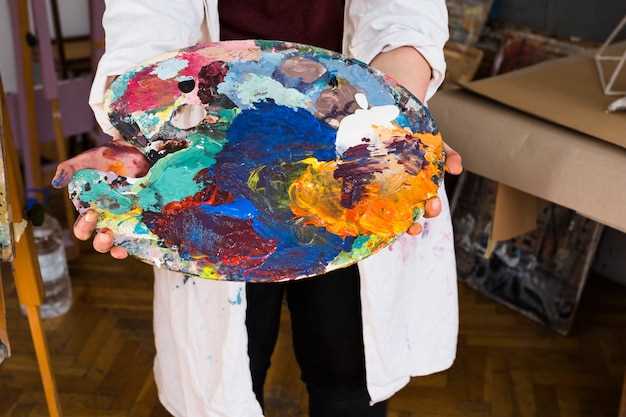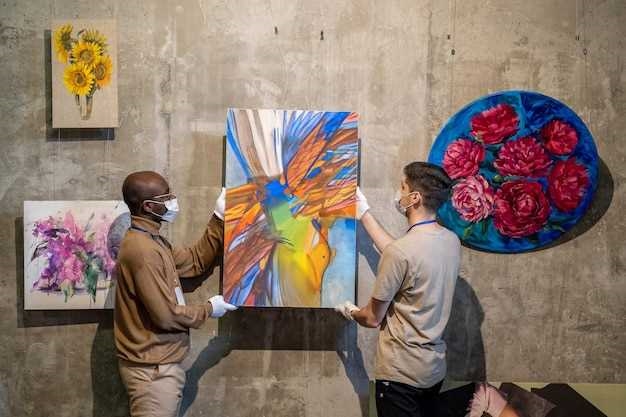
In the realm of contemporary artistic exhibitions, a captivating exploration unfolds as the boundaries between cultures blur and diverse perspectives converge. These dynamic showcases serve as a testament to the ever-evolving nature of art, where the fusion of global connections and multifaceted viewpoints intertwines to create a rich tapestry of creativity.
Within these vibrant spaces, artists from different corners of the world come together, their works resonating with the echoes of cultural exchange and the celebration of individuality. Through their art, they navigate the intricate web of globalization, embracing its potential to bridge gaps and foster understanding. Each stroke of the brush, each sculpted form, and each captured moment encapsulates a unique narrative, inviting viewers to embark on a journey of discovery.
As viewers immerse themselves in these exhibitions, they are confronted with a myriad of perspectives, each offering a distinct lens through which to perceive the world. The interplay between these diverse viewpoints sparks dialogue and challenges preconceived notions, encouraging a deeper understanding of the complexities that shape our global society. It is within these spaces that the power of art to transcend borders and ignite conversations becomes evident, as artists and viewers alike engage in a collective exploration of the human experience.
The Influence of Globalization on Contemporary Art
In today’s interconnected world, the impact of globalization on contemporary art cannot be overstated. As boundaries between nations blur and communication becomes instantaneous, artists are increasingly influenced by diverse cultures, ideas, and perspectives from around the globe. This fusion of influences has given rise to a new era of artistic expression that transcends traditional boundaries and challenges established norms.
Breaking Down Barriers
Globalization has provided artists with unprecedented access to a vast array of artistic traditions and techniques. Through the exchange of ideas and the sharing of artistic practices, artists are able to break down cultural barriers and explore new creative possibilities. This cross-pollination of artistic styles and techniques has led to the emergence of hybrid art forms that defy categorization and challenge conventional notions of artistic identity.
Cultural Exchange and Collaboration
Globalization has also facilitated increased cultural exchange and collaboration among artists from different parts of the world. Through international art exhibitions, residencies, and collaborative projects, artists have the opportunity to engage with diverse perspectives and engage in meaningful dialogue. This exchange of ideas not only enriches the artistic process but also fosters a greater understanding and appreciation of different cultures.
In conclusion, globalization has had a profound influence on contemporary art, shaping the way artists create, collaborate, and engage with the world. By embracing the diversity and interconnectedness of our global society, artists are able to push the boundaries of artistic expression and create works that reflect the complex and ever-evolving nature of our world.
Embracing Cultural Diversity in Art Exhibitions
Recognizing and celebrating the rich tapestry of cultures within contemporary art exhibitions is a vital aspect of fostering inclusivity and understanding. By embracing cultural diversity, these exhibitions provide a platform for artists from various backgrounds to express their unique perspectives and experiences.
One of the key benefits of embracing cultural diversity in art exhibitions is the opportunity to challenge and expand our own perspectives. By encountering artworks that reflect different cultural traditions, histories, and narratives, viewers are encouraged to question their preconceived notions and engage in meaningful dialogue.
Embracing cultural diversity also allows for the exploration of interconnectedness and shared experiences. Through the display of artworks that highlight the similarities and connections between different cultures, art exhibitions can foster a sense of unity and promote cross-cultural understanding.
Furthermore, embracing cultural diversity in art exhibitions can serve as a catalyst for social change. By showcasing artworks that address issues of identity, race, gender, and other forms of social inequality, these exhibitions have the power to spark important conversations and inspire action.
- By featuring artists from diverse backgrounds, art exhibitions can challenge the dominant narratives and power structures within the art world.
- Embracing cultural diversity in art exhibitions also creates opportunities for collaboration and exchange between artists from different cultures, leading to the creation of innovative and thought-provoking artworks.
- Additionally, by actively seeking out and promoting artists from underrepresented communities, art exhibitions can contribute to a more inclusive and equitable art world.
In conclusion, embracing cultural diversity in art exhibitions is essential for creating a more inclusive and interconnected art world. By providing a platform for artists from diverse backgrounds, these exhibitions not only enrich our understanding of different cultures but also challenge societal norms and promote social change.
Breaking Down Barriers: Global Artists in Local Exhibitions
In this section, we will delve into the dynamic and inclusive nature of contemporary art exhibitions, where artists from around the world come together to showcase their diverse perspectives and creative expressions. By examining the presence of global artists in local exhibitions, we will explore how these events transcend geographical boundaries and foster cultural exchange.
By featuring artists from different corners of the globe, local exhibitions provide a platform for a rich tapestry of artistic voices to be heard. These exhibitions serve as a melting pot of ideas, where artists bring their unique cultural backgrounds, experiences, and artistic techniques to the forefront. Through their works, they challenge traditional notions and break down barriers, inviting viewers to engage with art in new and thought-provoking ways.
Global artists in local exhibitions not only contribute to the diversity of artistic expressions but also promote cross-cultural understanding. Their presence encourages dialogue and fosters connections between artists and viewers from various cultural backgrounds. By showcasing art that reflects the complexities and nuances of different societies, these exhibitions create opportunities for individuals to expand their perspectives and gain a deeper appreciation for the interconnectedness of our global community.
Furthermore, the inclusion of global artists in local exhibitions challenges the notion of a singular artistic canon. It highlights the importance of embracing multiple narratives and perspectives, allowing for a more inclusive and comprehensive understanding of contemporary art. By breaking away from traditional boundaries and embracing diversity, these exhibitions pave the way for a more inclusive art world that celebrates the richness of global artistic expressions.
In conclusion, the presence of global artists in local exhibitions plays a crucial role in breaking down barriers and fostering cultural exchange. These exhibitions provide a platform for artists from diverse backgrounds to showcase their unique perspectives, challenge traditional notions, and promote cross-cultural understanding. By embracing diversity and inclusivity, these events contribute to a more interconnected and vibrant art world.
The Role of Technology in Promoting Global Artistic Exchange
In the realm of contemporary art, the fusion of technology and creativity has opened up new avenues for global artistic exchange. This section explores the pivotal role that technology plays in facilitating the exchange of diverse artistic expressions across borders and cultures. By harnessing the power of digital platforms, artists are able to transcend geographical limitations and connect with audiences from around the world.
Breaking Down Barriers
Technology has shattered the traditional barriers that once hindered the global dissemination of art. Through the internet and social media, artists can now showcase their work to a vast and diverse audience, transcending the limitations of physical exhibition spaces. This digital revolution has democratized the art world, allowing artists from all backgrounds and regions to gain exposure and recognition on a global scale.
Fostering Cultural Exchange
Technology not only enables artists to share their work, but also facilitates meaningful cultural exchange. Through virtual exhibitions, online forums, and collaborative platforms, artists can engage in dialogue with their peers from different parts of the world. This exchange of ideas and perspectives enriches the artistic process, leading to the creation of works that reflect the diverse global landscape.
Moreover, technology has also revolutionized the way art is consumed and experienced by audiences. Virtual reality (VR) and augmented reality (AR) technologies have allowed viewers to immerse themselves in art, transcending physical boundaries and experiencing artworks in new and interactive ways.
In conclusion, technology has become an indispensable tool in promoting global artistic exchange. It has broken down barriers, fostered cultural exchange, and transformed the way art is consumed. As technology continues to advance, the possibilities for global artistic collaboration and appreciation are boundless.
Challenging Stereotypes: Diverse Perspectives in Contemporary Art
In this section, we will delve into the captivating world of contemporary art, where artists from diverse backgrounds challenge stereotypes and offer unique perspectives. Through their creative expressions, these artists break free from conventional norms and explore the complexities of identity, culture, and society.
Embracing Cultural Diversity
Contemporary art exhibitions provide a platform for artists to celebrate and embrace cultural diversity. Through their artworks, artists from different parts of the world showcase their rich heritage, traditions, and customs. By challenging stereotypes associated with specific cultures, these artists encourage viewers to appreciate the nuances and complexities of diverse identities.
Breaking Boundaries and Redefining Norms
Contemporary art challenges societal norms by pushing boundaries and redefining traditional concepts. Artists explore themes such as gender, race, and sexuality, challenging preconceived notions and inviting viewers to question their own biases. By presenting alternative perspectives, these artworks encourage dialogue and promote inclusivity in the art world.
- Artists use various mediums, including painting, sculpture, and multimedia installations, to challenge stereotypes and provoke thought.
- Through their art, they aim to dismantle stereotypes and create a more inclusive and accepting society.
- Contemporary art exhibitions serve as a catalyst for conversations about diversity, representation, and social justice.
- By showcasing diverse perspectives, these exhibitions encourage viewers to question their own assumptions and broaden their understanding of the world.
Overall, contemporary art exhibitions provide a platform for artists to challenge stereotypes and offer diverse perspectives. Through their creative expressions, these artists contribute to a more inclusive and interconnected global art scene, where cultural diversity is celebrated and societal norms are questioned.
The Impact of Globalization on Artistic Identity and Representation
In the realm of contemporary art, the influence of globalization has become an undeniable force, shaping the artistic identity and representation of artists worldwide. This article explores the profound impact of globalization on the way artists perceive themselves, express their cultural backgrounds, and navigate the complexities of representation in a globalized art world.
1. Redefining Cultural Identity
Globalization has brought about a redefinition of cultural identity for artists, challenging traditional notions of nationality and cultural boundaries. Artists are no longer confined to a single cultural context but are instead influenced by a multitude of global experiences. This has led to a rich tapestry of artistic expressions that blend diverse cultural influences, creating a new sense of hybridity and fluidity in artistic identity.
2. Expanding Artistic Perspectives

Globalization has opened up new avenues for artists to explore and expand their artistic perspectives. Through increased access to information, travel, and exposure to different cultures, artists are able to draw inspiration from a global pool of ideas and techniques. This has resulted in a more diverse and inclusive art scene, where artists from different backgrounds can contribute their unique perspectives and challenge established norms.
- Artists now have the opportunity to collaborate with peers from around the world, fostering cross-cultural dialogue and exchange of ideas.
- Globalization has also facilitated the dissemination of art through digital platforms, allowing artists to reach a wider audience and transcend geographical limitations.
- Artists are increasingly incorporating elements of globalization, such as technology and mass media, into their work, reflecting the interconnectedness of the modern world.
In conclusion, globalization has had a profound impact on artistic identity and representation. It has redefined cultural identity, expanded artistic perspectives, and fostered a more inclusive and diverse art scene. As artists continue to navigate the complexities of a globalized art world, the intersection of globalization and artistic expression will undoubtedly shape the future of contemporary art.


